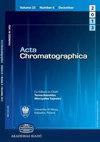A new approach for determination of urinary 8-hydroxy-2′-deoxyguanosine in cancer patients using reinforced solid/liquid phase microextraction combined with HPLC-DAD
IF 1.7
4区 化学
Q3 CHEMISTRY, ANALYTICAL
引用次数: 0
Abstract
The concentration level of urinary 8-hydroxy-2′-deoxyguanosine (8-OHdG), an oxidative stress biomarker for various diseases especially cancer, has been attracted as a pathway suitable for diagnostic purposes. Determination of urinary 8-OHdG is challenging due to its low level within a complex matrix. In this study, a new approach of solid/liquid phase microextraction technique prior to high-performance liquid chromatography diode-array detection (HPLC-DAD) analysis was developed for the determination of trace levels of 8-OHdG in urine samples. The solid/liquid phase microextraction device was constructed by reinforcement of multi-walled carbon nanotubes into the pores of a short segment 2.5 cm of hollow fiber microtube with two ends heat sealed. Based on the optimized procedure, the selected analyte was extracted from an acidic sample solution (10 mL adjusted at pH = 5) into the five extraction devices. After the extraction period (30 min), the 8-OHdG was eluted from the extraction device using methanol (350 µL) under ultrasonication for 5 min. The analytical performance of the method in synthetic urine samples showed good linearity (R2 > 0.999) with the limits of detection of 0.85 ng mL−1, and extraction recovery > 92.36%. The developed microextraction technique exhibited a confident sensitivity, feasible operation, and simplicity in comparison with other published methods and was valid to determinate trace 8-OHdG in urine cancer patients' samples by using a cheap and commonly available HPLC-DAD instrument.强化固/液相微萃取联合HPLC-DAD测定癌症患者尿中8-羟基-2′-脱氧鸟苷的新方法
尿8-羟基-2′-脱氧鸟苷(8-OHdG)是多种疾病特别是癌症的氧化应激生物标志物,其浓度水平被认为是一种适合诊断的途径。尿8-OHdG的测定是具有挑战性的,因为它在一个复杂的基质中的低水平。在本研究中,建立了一种高效液相色谱二极管阵列检测(HPLC-DAD)分析前的固/液相微萃取技术,用于测定尿样中痕量8-OHdG。该固/液相微萃取装置是将多壁碳纳米管补强于两端热封的2.5 cm短段中空纤维微管的孔内。根据优化后的程序,将选定的分析物从酸性样品溶液(pH = 5调整为10ml)中提取到五个提取装置中。提取时间(30 min)结束后,用甲醇(350µL)在超声下洗脱5 min。该方法在合成尿液样品中具有良好的线性关系(R2 = 0.999),检出限为0.85 ng mL−1,提取回收率为92.36%。与其他已发表的方法相比,所建立的微萃取技术具有可靠的灵敏度、可行的操作方法和简单的操作方法,可用于使用廉价且常用的HPLC-DAD仪器测定尿癌患者样品中的痕量8-OHdG。
本文章由计算机程序翻译,如有差异,请以英文原文为准。
求助全文
约1分钟内获得全文
求助全文
来源期刊

Acta Chromatographica
化学-分析化学
CiteScore
4.00
自引率
0.00%
发文量
55
审稿时长
2.3 months
期刊介绍:
Acta Chromatographica
Open Access
Acta Chromatographica publishes peer-reviewed scientific articles on every field of chromatography, including theory of chromatography; progress in synthesis and characterization of new stationary phases; chromatography of organic, inorganic and complex compounds; enantioseparation and chromatography of chiral compounds; applications of chromatography in biology, pharmacy, medicine, and food analysis; environmental applications of chromatography; analytical and physico-chemical aspects of sample preparation for chromatography; hyphenated and combined techniques; chemometrics and its applications in separation science.
 求助内容:
求助内容: 应助结果提醒方式:
应助结果提醒方式:


